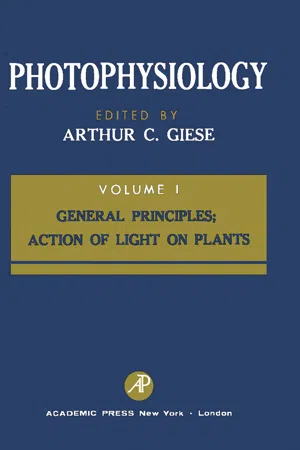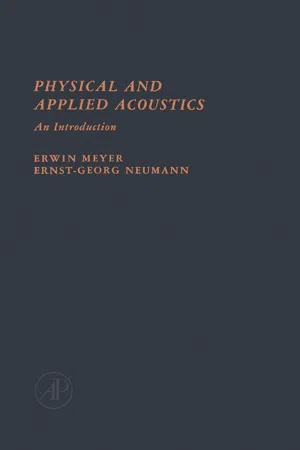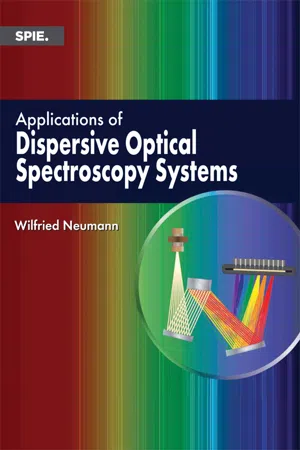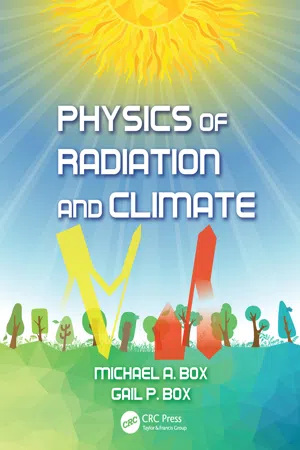Physics
Absorption
Absorption refers to the process by which energy, such as light or sound, is taken in and retained by a substance rather than being reflected or transmitted. In the context of physics, absorption is a fundamental concept in the study of wave behavior and the interaction of electromagnetic radiation with matter. It plays a crucial role in various phenomena, including the heating of materials and the creation of color.
Written by Perlego with AI-assistance
Related key terms
1 of 5
9 Key excerpts on "Absorption"
- Knut Stamnes, Gary E. Thomas, Jakob J. Stamnes(Authors)
- 2017(Publication Date)
- Cambridge University Press(Publisher)
4 Absorption by Solid, Aqueous, and Gaseous Media 4.1 Introduction Most particles in the atmosphere and the ocean (except for the density irregularities leading to Rayleigh scattering) are also absorbers of radiation. Absorption causes the incident radiation to be further weakened (in addition to scattering) by losses within the particles themselves. As explained in Chapter 3, the net effect of scat- tering and Absorption is called attenuation or extinction. Absorption is inherently a quantum process resulting from the fact that matter contains energy levels that can be excited by the Absorption of radiation. A transition from an initial quantum state to a higher-energy state is highly dependent on the frequency or energy of the incident light. When the photon energy is close to the energy difference between the initial and final state, the atoms and light may be said to be in resonance, and the Absorption is comparatively strong. Conversely, when the photon energy is not close to the transition energy, the Absorption is often much weaker than the scattering, and is not easily measurable. This energy selectivity is the outstanding characteristic of Absorption. (In contrast, scattering is generally much less selective, and usually has a smoothly varying efficiency with wavelength.) Selective Absorption causes individual molecular Absorption spectra to be very complex. The resonances are usually very sharp, and because of the many modes of excitation of molecules (particularly the polyatomic molecules of greatest interest to us) there may exist tens to hundreds of thousands of discrete Absorption lines in molecular spectra. The dominant characteristic of such spectra is the presence of dark regions in the absorp- tion spectrum. These broad spectral features are called molecular Absorption bands, in which lines are clustered closely in frequency groups. Under low resolution, these bands appear to be nearly continuous functions of frequency.- Bruce Hapke(Author)
- 1993(Publication Date)
- Cambridge University Press(Publisher)
3 The Absorption of light 3.A. Introduction The differential reflection and scattering of light as a function of wavelength form the basis of the science of reflectance spectroscopy. This chapter discusses the Absorption of electromagnetic radiation by solids and liquids. The classical descriptions of Absorption and disper- sion are derived first, followed by a brief discussion of these processes from the point of view of quantum mechanics and modern physics. Finally, we summarize the various types of mechanisms by which light is absorbed. 3.B. Classical dispersion theory 3.B.I. Conductors: the Drude model The simplest model for Absorption and dispersion by a solid is that of Drude (1959). This model assumes that some of the electrons are free to move within the lattice, while the ions are assumed to remain fixed. These approximate the conditions within a metal. The average electric-charge density associated with the semifree electrons is equal to the average of that associated with the lattice ions, so that the total electric-charge density p e = 0. Because the quantum-mechanical wave functions of the conduction electrons are not localized in a metal, the local field E loc seen by the electrons is equal to the macroscopic field E e . Thus, the force on each electron is - eE e , where e is the charge of an electron. Assume that E e is parallel to the x axis. 24 3.B. Classical dispersion theory 25 In addition to the electric field, there is a force due to collisions of each electron with the lattice, resulting in nonradiative loss of energy. This force, which is proportional to the velocity dm/ dt of the elec- tron, but opposite in direction, may be characterized by a parameter 3, defined such that the average collisional force on the electron is given by —2ir > Bm e dx/dt, where m e is the mass of the electron, and x is the displacement of the electron relative to the lattice.- eBook - PDF
- Park Nobel(Author)
- 2012(Publication Date)
- Academic Press(Publisher)
[See Alberty (1983), Calvert and Pitts (1966), Cowan and Drisko (1976), Depuy and Chapman (1972), Turro (1978), and Wayne (1988) for a more thorough treatment of the topics in this section.] Role of Electrons in Absorption Event From a classical viewpoint, an electron is a charged particle that can move in some orbit around an atomic nucleus. Its energy depends both on the location of the orbit in space and on how fast the electron moves in its orbit. The increase in energy of an electron upon absorbing a photon could be used either to transfer that electron into an orbit that lies at a higher energy than the original orbit or to cause the electron to move more rapidly about the nucleus than it did before the light arrived. The locations of various possible electron orbits and the speeds for electrons moving in them are both limited to certain discrete, or allowed, values, a phenomenon that has been interpreted by quantum mechanics. Hence, Absorption of Light by Molecules 205 the energy of an electron in an atom or molecule can change only by certain specific amounts. Light of the appropriate wavelength will have the proper energy to cause the electron to move from one possible energetic state to another. For light Absorption to occur, therefore, the energy of a photon as given by Equation 4.2 must equal the difference in energy between some allowed excited state of the atom or molecule and the initial state, the latter usually being the ground (lowest energy) state. During light Absorption an interaction occurs between the electromagnetic field of the light and some electron. Because electrons are charged particles, they experience a force when they are in an electric field. The oscillating electric field of light (Fig. 4.1) thus represents a periodic driving force acting on electrons. This electric field—a vector having a certain direction in space, such as along the vertical axis in Figure 4.1—causes or induces the electrons to move. - eBook - PDF
Photophysiology
General Principles; Action of Light on Plants
- Arthur C. Giese(Author)
- 2013(Publication Date)
- Academic Press(Publisher)
Chapter 4 Absorption SPECTRA, SPECTROPHOTOMETRY, AND ACTION SPECTRA Mary Belle Allen Kaiser Foundation Research Institute Laboratory of Comparative Biology Richmond, California 1. Introduction—Measurement of Absorption Spectra of Scattering Materials The Absorption spectrum of a substance is often a useful property for its characterization in biological systems. Measurement of Absorption spectra provides a nondestructive method of both qualitative and quanti-tative analysis that can frequently be carried out on very small samples. Since the general principles of Absorption spectroscopy in the ultraviolet, visible, and infrared have been discussed in several recent treatises (Hiskey, 1955; Scott, 1955; Clark, 1955; West, 1960; Gibson, 1949), it will be assumed that the reader is familiar with these principles, and the emphasis in this chapter will be on the special problems of measure-ment of Absorption spectra of biological materials. The most serious of these problems is that the spectra must often be measured in turbid suspensions, rather than in clear solutions or homogeneous solids. When light passes through a homogeneous medium there is no attenuation of the beam unless the light is of a wavelength correspond-ing to the difference between two energy levels of the molecules com-prising the medium. In this case, the light is absorbed by the molecules; the pattern of light Absorption obtained as one varies the wavelength is the Absorption spectrum. In a turbid suspension, however, the light is also reflected from the surface of the particles and refracted by passage through them, as shown in Fig. 1. This results in an attenuation of the light beam in addition to that due to Absorption of light. Light scattering is a complex phenomenon which depends on the size of the scattering particles, their shape, and the refractive index difference between the particles and suspending medium. - eBook - PDF
Physical and Applied Acoustics
An Introduction
- Erwin Meyer(Author)
- 2012(Publication Date)
- Academic Press(Publisher)
3.1. Absorption IN GASES 97 The classical attenuation can be taken as a lower limit to the attenuation. Generally, the measured value is very much higher. Mercury and the rare gases are examples of monatomic materials whose Absorption coefficients are only slightly higher than the values to be expected from the classical theory. The most im portant source of high attenuation is molecular sound Absorption. 3.1.2. M olecular S ound A bsorption The mechanism of molecular sound Absorption will be described by taking a polyatomic gas as an example. If an amount of energy is supplied quickly to a gas volume (by sudden compression, for example), the work done on it increases the translational energy of the gas molecules and thus, according to the kinetic theory of gases, the gas pressure. A molecule can store this energy not only as an increase in the velocity of its center of gravity, but also as rotation of the individual atoms of the molecule around each other or oscillation of the atoms with respect to each other. The internal degrees of rotational freedom are very quickly excited by an increase of energy; the growth curve for the energy then looks like the curve of the total energy in Fig. 3.1. The internal oscillations of the molecule, Fig. 3.1. Relaxation of the energy of the g oscillatory degrees of freedom. ^ Total energy Energy o f the oscilla-tory degree of freedom T -J Relaxation time Tim e in contrast, just build up gradually as a result of a sudden impact, and their energy increases only gradually at the expense of the translational and rotational energy. A thermal equilibrium among the three forms of energy is established only after a definite time (Fig. 3.1). The delay in reaching thermal equilibrium is called relaxation, and the time constant of this phenomenon is called the relaxation time τ. - Neumann, Wilfried(Authors)
- 2015(Publication Date)
Chapter 1 Transmission, Absorption, and Reflection Measurements 1.0 Introduction The interaction between light and matter may lead to the following effects: 1. Transmission without interaction; 2. Reflection without Absorption effects; 3. Transmission and/or reflection, where the light changes the energetic state of the sample; and 4. Transmission and/or reflection with light scattering effects at the sample. The law of conservation of energy states that the light transmitted through any sample, plus the sum of reflections by the sample, results in the factor 1 of the energy introduced: T þ R ¼ 1 : ð 1 : 1 Þ The law does not account for the fact that transmitted light may be refracted, diffracted, or scattered by the sample. It also does not consider that absorbed energies may appear in the beam as luminescent signals. Similar effects can modify the reflected light beam. If one precisely measures both the transmission and reflection of a sample, the sum may be < 1, having no error in measurement; however, if the result turns out to be > 1, one would have a perpetuum mobile (perpetual motion machine). 1.0.1 Principles A measurement of the integrated or wavelength-dependent light flux in front of and after a sample will reveal no difference in case 1. From a practical perspective, this scenario does not always apply, as shown in Fig. 1.1. The figure illustrates the interactions between light and matter. The left side shows the possible effects of a light beam impinging a transmitting sample. A beam of collimated light e 0 hits the sample or the sample 1 container at a perpendicular angle. Reflections r may occur at the front surface and again at the rear. Besides the light loss due to Absorption, the sample may scatter some light without changing the photon energy fs . It may also scatter light at a different state of energy/wavelength rs .- eBook - PDF
- Michael A. Box, Gail P. Box(Authors)
- 2015(Publication Date)
- CRC Press(Publisher)
That is, (a photon of) energy is absorbed from the radiation field. On the other hand, the second integral is negligible unless ω fi ≈ −ω ; that is unless E f ≈ E i − ℏω . In this case, (a photon of) energy Chapter 9 – Absorption and Emission of Radiation 203 is emitted . Of course, only one of these conditions will apply in any given instance. (An exception occurs in the microwave region, where the relevant frequencies are very low: this spectral range has very little relevance to the subject matter of this book.) We will now look more closely at each of these cases in turn. 9.3.1.3 Absorption If we assume the first situation, it follows that the sec -ond integral is zero, and we find for the probability that the system is in the state f at time t a t d eA m M F t f fi f i ( ) = ( ) é ë ê ù û ú ( ) -( ) ò 2 0 2 2 1 2 w w w w w w , D (9.81) where M e fi f i j i j w j j ( ) = × Ñ × å k r l (9.82) and F t t , cos tildenosp tildenosp tildenosp w w w ( ) = -1 2 (9.83) For large values of t , the function F becomes strongly peaked and may be treated as a delta function: lim , t F t t ® ¥ ( ) ( ) ® ( ) tildenosp tildenosp w p d w (9.84) Finally, we obtain a t eA m M t f fi fi fi ( ) = ( ) é ë ê ê ù û ú ú ( ) 2 0 2 2 2 p w w (9.85) which increases linearly with time. The transition rate for Absorption is defined by W d dt a t eA m M fi f fi fi fi = ( ) = ( ) é ë ê ê ù û ú ú ( ) 2 0 2 2 2 p w w (9.86) which is essentially Fermi’s golden rule. We may re-express this in terms of the intensity per unit frequency range using Equation 9.15: W m c e I M fi fi fi fi fi = æ è ç ö ø ÷ ( ) ( ) 4 4 2 2 2 0 2 2 p pe w w w (9.87) Finally, we may also define the Absorption cross section as the rate at which energy is removed from the beam, per atom, remembering that the removal of a photon means the removal of energy ℏω : s w w p a w w fi fi fi fi fi fi fi I W m M = ( ) = ( ) planckover2pi planckover2pi 4 2 2 2 2 (9.88) where α = e 2 /4 πε 0 ℏ c is the fine structure constant. - Craig F. Bohren, Donald R. Huffman(Authors)
- 2008(Publication Date)
- Wiley-VCH(Publisher)
We limit our treatment, therefore, to scattering by single particles within the framework of classical electromagnetic theory and linear optics. Not all the examples given above fall withn these restrictions. The colors of rocks and foliage, for example, involve complicated interactions of light with many densely packed centers of scatter- ing and Absorption. Nevertheless, all detailed treatments of the more com- plicated phenomena begin with those that we shall study. 1.1 PHYSICAL BASIS FOR SCA'IITRING AND Absorption Scattering of electromagnetic waves by any system is related to the heterogene- ity of that system: heterogeneity on the molecular scale or on the scale of aggregations of many molecules. Regardless of the type of heterogeneity, the underlying physics of scattering is the same for all systems. Matter is composed of discrete electric charges: electrons and protons. If an obstacle, which could be a single electron, an atom or molecule, a solid or liquid particle, is illuminated by an electromagnetic wave (Fig. l.l), electric charges in the obstacle are set into oscillatory motion by the electric field of the incident wave. Accelerated electric charges radiate electromagnetic energy in all direc- tions; it is this secondary radiation that is called the radiation scattered by the 3 4 INTRODUCTION INCIDENT ____) - - - - _____). - 08 S TACL E Figure 1.1 Scattering by an obstacle obstacle: Scattering = excitation + reradiation In addition to reradiating electromagnetic energy, the excited elementary charges may transform part of the incident electromagnetic energy into other forms (thermal energy, for example), a process called Absorption. Scattering and Absorption are not mutually independent processes, and although, for brevity, we often refer only to scattering, we shall always mean Absorption as well. 1.2 SCATTERING BY FLUCTUATIONS AND BY PARTICLES Everything except a vacuum is heterogeneous in some sense.- eBook - PDF
- Dieter Schu??cker(Author)
- 1999(Publication Date)
- WSPC(Publisher)
These transitions have been treated in detail in 1. The sharp decrease of absorptivity of metals in the visible range of light is associated to a minimum quantum energy, that is just large enough to carry out the excitation of the metal atoms, that means to be absorbed by the atomic electrons. Above this limit mainly Absorption by the free electrons can take place 11.21. Turning now to insulating materials, the high absorptivity for low wavelengths is also caused by the excitation of atomic energy levels as in the case of metals, where the upper limit of the wavelength for this Absorption mechanism of course depends on the properties of the material and is thus somewhat different from that for metals. With increasing wavelength a range of very low absorptivity is reached since the photon energy is too low to excite atomic energy levels, but the light frequency is too high to give rise to a considerable vibration of the atomic nuclei with their large mass that is caused by dielectric polarization of the atoms in the lattice and can give rise to very strong Absorption, a mechanism that sets on above a wavelength of around 5 urn, thus allowing an excellent Absorption of insulating materials for the wavelength of the CO2 laser of X = 10.6 urn. The latter mechanism of Absorption, that applies also to gaseous molecules and has to some extent been treated in 1, is discussed in detail in one of the following parts 11.21. 7.1.2 Reflection, Absorption and transmission Due to the above Absorption mechanisms, that take place in the bulk of the materials, a light wave entering the latter becomes weaker and weaker due to bulk Absorption during the penetration of the material and is finally extinguished.
Index pages curate the most relevant extracts from our library of academic textbooks. They’ve been created using an in-house natural language model (NLM), each adding context and meaning to key research topics.








